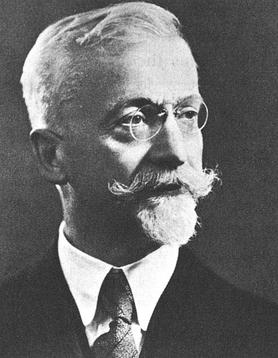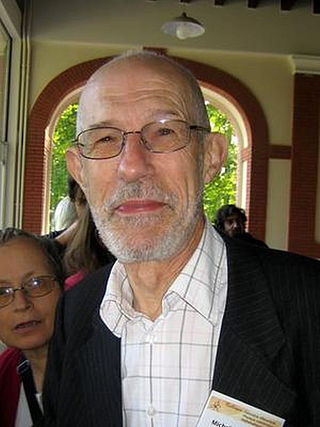
Gaston Maurice Julia was a French Algerian mathematician who devised the formula for the Julia set. His works were popularized by French mathematician Benoit Mandelbrot; the Julia and Mandelbrot fractals are closely related. He founded, independently with Pierre Fatou, the modern theory of holomorphic dynamics.
In functional analysis, a discipline within mathematics, given a C*-algebra A, the Gelfand–Naimark–Segal construction establishes a correspondence between cyclic *-representations of A and certain linear functionals on A. The correspondence is shown by an explicit construction of the *-representation from the state. It is named for Israel Gelfand, Mark Naimark, and Irving Segal.

Élie Joseph Cartan was an influential French mathematician who did fundamental work in the theory of Lie groups, differential systems, and differential geometry. He also made significant contributions to general relativity and indirectly to quantum mechanics. He is widely regarded as one of the greatest mathematicians of the twentieth century.

Jean Alexandre Eugène Dieudonné was a French mathematician, notable for research in abstract algebra, algebraic geometry, and functional analysis, for close involvement with the Nicolas Bourbaki pseudonymous group and the Éléments de géométrie algébrique project of Alexander Grothendieck, and as a historian of mathematics, particularly in the fields of functional analysis and algebraic topology. His work on the classical groups, and on formal groups, introducing what now are called Dieudonné modules, had a major effect on those fields.
The Leroy P. Steele Prizes are awarded every year by the American Mathematical Society, for distinguished research work and writing in the field of mathematics. Since 1993, there has been a formal division into three categories.

Paul Dubreil was a French mathematician.
In functional analysis, an abelian von Neumann algebra is a von Neumann algebra of operators on a Hilbert space in which all elements commute.
Pierre Samuel was a French mathematician, known for his work in commutative algebra and its applications to algebraic geometry. The two-volume work Commutative Algebra that he wrote with Oscar Zariski is a classic. Other books of his covered projective geometry and algebraic number theory.
In the theory of von Neumann algebras, a part of the mathematical field of functional analysis, Tomita–Takesaki theory is a method for constructing modular automorphisms of von Neumann algebras from the polar decomposition of a certain involution. It is essential for the theory of type III factors, and has led to a good structure theory for these previously intractable objects.
The Séminaire Nicolas Bourbaki is a series of seminars that has been held in Paris since 1948. It is one of the major institutions of contemporary mathematics, and a barometer of mathematical achievement, fashion, and reputation. It is named after Nicolas Bourbaki, a group of French and other mathematicians of variable membership.
Continuation of the Séminaire Nicolas Bourbaki programme, for the 1950s.
In mathematics, affiliated operators were introduced by Murray and von Neumann in the theory of von Neumann algebras as a technique for using unbounded operators to study modules generated by a single vector. Later Atiyah and Singer showed that index theorems for elliptic operators on closed manifolds with infinite fundamental group could naturally be phrased in terms of unbounded operators affiliated with the von Neumann algebra of the group. Algebraic properties of affiliated operators have proved important in L2 cohomology, an area between analysis and geometry that evolved from the study of such index theorems.
In mathematics, a commutation theorem for traces explicitly identifies the commutant of a specific von Neumann algebra acting on a Hilbert space in the presence of a trace.

Michel Demazure is a French mathematician. He made contributions in the fields of abstract algebra, algebraic geometry, and computer vision, and participated in the Nicolas Bourbaki collective. He has also been president of the French Mathematical Society and directed two French science museums.

Éléments de mathématique is a series of mathematics books written by the pseudonymous French collective Nicolas Bourbaki. Begun in 1939, the series has been published in several volumes, and remains in progress. The series is noted as a large-scale, self-contained, formal treatment of mathematics.
In mathematics, Jordan operator algebras are real or complex Jordan algebras with the compatible structure of a Banach space. When the coefficients are real numbers, the algebras are called Jordan Banach algebras. The theory has been extensively developed only for the subclass of JB algebras. The axioms for these algebras were devised by Alfsen, Schultz & Størmer (1978). Those that can be realised concretely as subalgebras of self-adjoint operators on a real or complex Hilbert space with the operator Jordan product and the operator norm are called JC algebras. The axioms for complex Jordan operator algebras, first suggested by Irving Kaplansky in 1976, require an involution and are called JB* algebras or Jordan C* algebras. By analogy with the abstract characterisation of von Neumann algebras as C* algebras for which the underlying Banach space is the dual of another, there is a corresponding definition of JBW algebras. Those that can be realised using ultraweakly closed Jordan algebras of self-adjoint operators with the operator Jordan product are called JW algebras. The JBW algebras with trivial center, so-called JBW factors, are classified in terms of von Neumann factors: apart from the exceptional 27 dimensional Albert algebra and the spin factors, all other JBW factors are isomorphic either to the self-adjoint part of a von Neumann factor or to its fixed point algebra under a period two *-anti-automorphism. Jordan operator algebras have been applied in quantum mechanics and in complex geometry, where Koecher's description of bounded symmetric domains using Jordan algebras has been extended to infinite dimensions.
In mathematics, a singular trace is a trace on a space of linear operators of a separable Hilbert space that vanishes on operators of finite rank. Singular traces are a feature of infinite-dimensional Hilbert spaces such as the space of square-summable sequences and spaces of square-integrable functions. Linear operators on a finite-dimensional Hilbert space have only the zero functional as a singular trace since all operators have finite rank. For example, matrix algebras have no non-trivial singular traces and the matrix trace is the unique trace up to scaling.

Michèle Vergne (born August 29, 1943, in L’Isle-Adam, Val d´Oise) is a French mathematician, specializing in analysis and representation theory.

Nicole Berline is a French mathematician.
In mathematics, the notion of a cyclic and separating vector is important in the theory of von Neumann algebras, and in particular in Tomita–Takesaki theory. A related notion is that of a vector which is cyclic for a given operator. The existence of cyclic vectors is guaranteed by the Gelfand–Naimark–Segal (GNS) construction.







